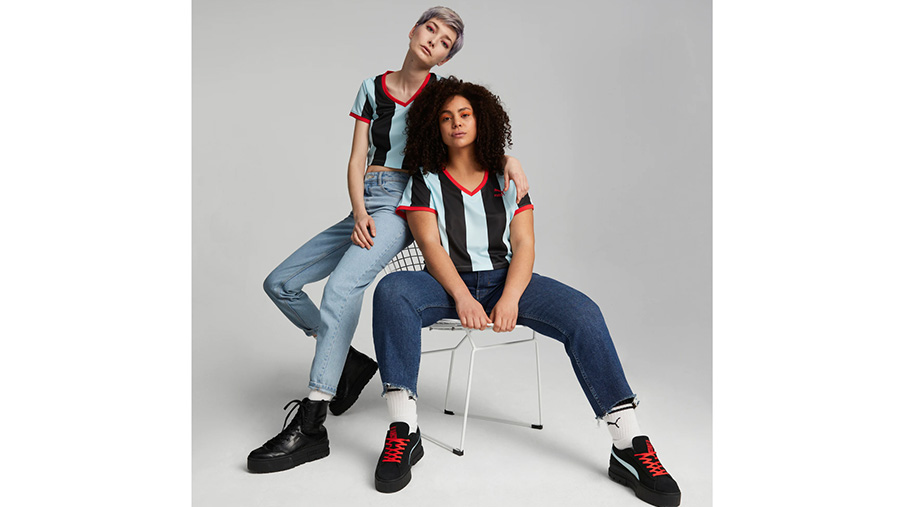Puma reiterated its outlook for the year despite market volatility while reporting another quarterly record of sales and EBIT performance in the third quarter ending September 30. Sales in the third quarter grew 16.9 percent on a currency-adjusted basis, led by growth of 18.8 percent in the Americas region and 18.5 percent in EMEA.
2022 Third Quarter Highlights
- Sales increased by 16.9 percent currency adjusted (ca) to €2,354 million (+23.9 percent reported/Q3 2021: €1,900 million);
- Gross profit margin decreased to 46.8 percent (Q3 2021: 47.4 percent);
- Operating expenses (OPEX) increased by 25.8 percent to €853 million (Q3 2021: €678 million);
- Operating result (EBIT) improved by 12.6 percent to €258 million (Q3 2021: €229 million) resulting in an EBIT margin of 10.9 percent (Q3 2021: 12.0 percent); and
- Net earnings improved by 1.8 percent to €146 million (Q3 2021: €144 million.)
2022 Nine Months Highlights
- Sales increased by 18.2 percent ca to €6,269 million (9M 2021: €5,038 million);
- Gross profit margin decreased to 46.8 percent (9M 2021: 47.8 percent);
- Operating expenses (OPEX) increased by 22.2 percent to €2,357 million (9M 2021: €1,930 million);
- Operating result (EBIT) improved to €600 million (9M 2021: €492 million), resulting in an EBIT margin of 9.6 percent (9M 2021: 9.8 percent); and
- Net earnings improved to €352 million (9M 2021: €302 million).
Bjørn Gulden, CEO, Puma SE, said, “Despite all the global uncertainties, the third quarter was again a very good quarter for us. With sales being up 24 percent in Euro terms at €2,354 million and EBIT up 13 percent to €258 million, it was the best quarter in Puma’s history. Improved product availability due to a more stable supply chain, better than expected sell-through and Puma’s continued global brand momentum overcompensated all the negative external factors. During the first nine months, we achieved sales growth of 24 percent in Euro terms (18 percent ca) to €6,269 million and an EBIT of €600 million.
“Our performance categories like running, soccer and basketball continue to do very well. We still see strong demand for Footwear, but we also observe that high inventory levels in the market, especially for apparel, have led retailers to order more cautiously than a year ago. With almost all our markets up double-digit, we continue to see a strengthening of the Puma brand and our sales globally.
“We expect continued volatility in the market during the fourth quarter but are confident that we can deliver according to our full-year outlook.
“We will also continue with our people-first approach and always prioritize the health and safety of our employees and not save on anything. At the moment, this is especially true for our people and their families in Ukraine, who have our full sympathy and support. At the same time, we will also continue to invest in our people, brand and infrastructure, as sales growth and higher market shares will be more important than short-term profit optimization.”
Third Quarter 2022
- Sales increased by 16.9 percent (ca) to €2,354.4 million (+23.9 percent reported), representing the highest quarterly sales in Puma’s history. The Americas region recorded a strong sales growth of 18.8 percent currency adjusted. Sales in EMEA were up 18.5 percent currency adjusted, driven by strong growth across almost all key markets in Europe. The Asia/Pacific region recorded sales growth for the first time this year (+9.8 percent currency adjusted). While COVID-19-related lockdown measures still impacted the business in Greater China, other key markets in Asia/Pacific delivered strong growth. Sales in Footwear were up 33.2 percent (ca) and Apparel grew 9.9 percent currency adjusted, driven by continued strong demand for its Performance categories, including Running & Training, Teamsports, Basketball, and Sportstyle. Sales in Accessories were down 10.2 percent currency adjusted because of a softer leg and bodywear business, especially in North America.
- Puma’s Wholesale business increased by 19.9 percent (ca) to €1,864.6 million and its DTC business was up by 6.5 percent (ca) to €489.7 million. Sales in owned & operated retail stores increased 4.2 percent (ca) and e-commerce increased 11.8 percent (ca). Puma said in its press release, “We continued to focus on our strategy of being the best partner for our retailers, which supported the strong growth in our Wholesale distribution channel. At the same time, better product availability led to stronger growth in DTC, predominantly in e-commerce.”
- The gross profit margin decreased by 60 basis points to 46.8 percent, mainly caused by higher sourcing prices due to raw materials and freight rates and an unfavorable channel mix, while price adjustments and currencies had a positive impact.
- Operating expenses (OPEX) increased by 25.8 percent to €853.2 million due to higher marketing expenses, a higher number of retail stores in operation and higher sales-related distribution costs. Because of ongoing operational inefficiencies due to COVID-19, especially in supply chain and warehousing, the OPEX ratio increased to 36.2 percent (Q3 2021: 35.7 percent).
- The operating result (EBIT) increased by 12.6 percent to €257.7 million (Q3 2021: €228.9 million) and the EBIT margin came in at 10.9 percent (Q3 2021: 12.0 percent).
- Net earnings increased by 1.8 percent to €146.4 million (Q3 2021: €143.8 million), reflecting a decrease in the financial result due to currency effects. Consequently, earnings per share amounted to €0.98 (Q3 2021: €0.96).
Nine Months 2022
- Sales increased by 18.2 percent (ca) to €6,268.5 million (+24.4 percent reported). Americas led the growth with a 28.1 percent (ca) increase in sales, followed by the EMEA region, with all key markets in Europe contributing strong growth to a 21.4 percent (ca) increase in sales. Sales in the Asia/Pacific region were down 3.7 percent (ca) due to geopolitical tensions and COVID-19-related lockdown measures in Greater China, while other major markets in Asia/Pacific recorded strong growth. All product divisions delivered strong growth, with Footwear being up 24.0 percent (ca), Apparel up 14.7 percent (ca) and Accessories up 8.9 percent (ca).
- The Wholesale business was up 21.8 percent (ca) to €4,956.0 million and its DTC business increased by 6.4 percent (ca) to €1,312.5 million with growth in owned and operated retail stores (+11.1 percent ca) and a decline in e-commerce (-2.1 percent ca).
- The gross profit margin decreased by 100 basis points to 46.8 percent (9M 2021: 47.8 percent), mainly caused by an unfavorable geographical and channel mix and higher sourcing prices due to raw materials and freight rates, which were partially offset by currencies and price adjustments.
- Operating expenses (OPEX) increased by 22.2 percent to €2,357.3 million (9M 2021: €1,929.5 million). Higher marketing expenses, a higher number of retail stores in operation, higher sales-related distribution and warehousing costs and operational inefficiencies due to COVID-19 contributed to this increase; however, the respective OPEX ratio decreased to 37.6 percent (9M 2021: 38.3 percent) as a result of higher sales growth and continued OPEX control.
- The operating result (EBIT) increased by 22.0 percent to €600.1 million (9M 2021: €492.1 million) due to strong sales growth and continued OPEX control. Consequently, the EBIT margin came in at 9.6 percent (9M 2021: 9.8 percent).
- Net earnings increased by 16.7 percent to €352.1 million (9M 2021: €301.7 million), and earnings per share were €2.35 (9M 2021: €2.02).
Working Capital
The working capital increased by 86.2 percent to €1,339.0 million (September 30, 2021: €719.0 million). Inventories were up by 72.3 percent to €2,350.2 million (September 30, 2021: €1,363.9 million). The current inventory level is impacted by currency effects, higher raw material prices, freight rates, and earlier product purchasing. In addition, the third quarter of last year was comparably low due to COVID-19-related factory closures in South Vietnam. Trade receivables increased by 21.9 percent to €1,290.3 million (September 30, 2021: €1,058.6 million), mainly due to strong sales growth. On the liabilities side, trade payables increased by 50.5 percent to €1,810.2 million (September 30, 2021: €1,202.8 million).
2022 Outlook
Puma said, “Puma achieved record sales and EBIT in the first nine months of 2022 based on continued brand momentum, successful product launches and the best possible service to our retail partners and consumers.
“While the first nine months of the year have been strong for Puma, we continue to navigate in a highly uncertain geopolitical, macroeconomic and competitive environment. The situation in Ukraine, a global energy crisis, persistent inflation and rising interest rates are leading to uncertain consumer behavior and volatile demand. COVID-19-related restrictions are still impacting business in Greater China, and higher freight rates and raw material prices continue to put pressure on margins. At the same time, the overall inventory levels have increased at both retailers and brands. The higher inventory levels, combined with uncertainty and volatility in the markets, are leading to increased promotional activity and retailers ordering later and more conservatively.
“Despite the highly uncertain environment, Puma reiterates its 2022 outlook for currency-adjusted mid-teens sales growth and an operating result (EBIT) in a range of €600 million to €700 million (2021: €557 million). Puma’s net earnings are expected to improve accordingly. The development of the gross profit margin and OPEX ratio will continue to depend largely on the extent and duration of the negative impacts described above.
“In line with previous expectations, Puma estimates that inflationary pressures from higher freight rates and raw material prices, as well as operational inefficiencies due to COVID-19 and the Ukraine crisis, will dilute the profitability in 2022.
In line with the strategy, Puma will continue to focus on managing short-term challenges without compromising the mid-term momentum of the brand. Consequently, sales growth and market share gains will have priority over short-term profitability. The strong and profitable growth in the first nine months of the year, a strong order book, an exciting product line-up, as well as very good feedback from retailers and consumers, make us confident for the mid-term success and growth of Puma.
Photo courtesy Puma













